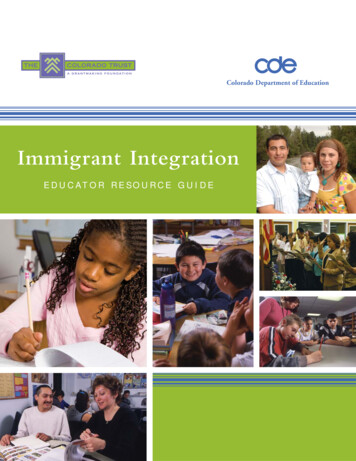
Transcription
Colorado Department of EducationImmigrant IntegrationE D U C ATO R R E S O U R C E G U I D E
ACKNOWLEDGEMENTSThe Immigrant Integration Educator Resource Guide was prepared by Nancy L. Commins, Ph.D., Consultant,Colorado Department of Education. The Colorado Department of Education and The Colorado Trust alsoextend our thanks to the many other individuals who provided valuable input toward the development ofthis guide – in particular, we thank Dr. Robin Waterman for her early work in soliciting broad input toconceptualize and embark on this project. Other contributors included:Patricia Baca, Ed.D.The Colorado Trust, Board of TrusteesFrank KimAsian Pacific Development CenterCarol BreslauThe Colorado TrustRanelle LangGreeley-Evans School District 6Juvenal CervantesCentennial BOCESSara ManzaresColorado Department of EducationEnglish Language Acquisition UnitPatrick B. ChapmanColorado Department of EducationOffice of Special ServicesFlora Comejo-LenhartPueblo School District No. 60Administrative Services CenterMarcela de la MarConsulate General of MexicoSusan Downs-KarkosThe Colorado TrustMarilyn EatonColorado State Refugee ProgramKathy EscamillaBUENO Center for Multicultural EducationManuel EscamillaRocky Mountain SERMegan FerlandColorado Children’s CampaignAnita FoxworthColorado Department of EducationOffice of Special ServicesBarbara M. Medina, Ph.D.Colorado Department of EducationEnglish Language Acquisition UnitTomas MejiaColorado Department of EducationEnglish Language Acquisition UnitMirjana OlujicJewish Family Services of ColoradoMaxine QuintanaMayor’s Office for Education and ChildrenGloria RichardsonMayor’s Office for Education and ChildrenBarbara SampleSpring Institute for Intercultural LearningPamela M. SmithColorado Department of Education/AEFLAMartha M. Urioste, Ph.D.Education ConsultantSiri VonthieresContractor, Colorado Department of Education/ELAURicardo GarciaColorado Statewide Parent CoalitionPatty VoorhisMontrose County School District RE-1JLee Ann GottKenton Elementary SchoolStacy WeisbergJewish Family Services of ColoradoMaria GuajardoMayor’s Office for Education and ChildrenJoe Wismann-HortherSpring Institute for Intercultural LearningMarie GuinetMigrant Education Program, Region II
Table of ContentsIntroduction2Chapter 1:School Enrollment4Chapter 2:School Culture and Climate7Chapter 3:Family and Community Outreach12Chapter 4:Classroom Instruction18Chapter 5:Student Assessment25Chapter 6:Early Childhood Education30Chapter 7:Programs for Middle and High School Youth36Chapter 8:School-based Adult ESL and Family Literacy42Conclusion481EDUCATOR RESOURCE GUIDE
IntroductionPURPOSEBACKGROUNDThe Immigrant Integration Educator ResourceGuide identifies, explains and provides specificrecommendations for promoting immigrantintegration in schools. Intended primarily asa resource for district administrators, schooladministrators and teachers, the guide providesan overview of the critical areas that influenceimmigrant integration in schools – from schoolenrollment and classroom instruction to familyand community outreach.Colorado is an increasingly diverse state, withpeople across the country and across the globearriving here to enjoy beautiful landscapes, ahigh quality of life, and education and economicopportunities. With such demographic shiftscome increased opportunities to infuse the statewith new ideas, energy and vitality, as well aschallenges – including basic communicationissues that occur when some newcomers have notyet mastered English. Other challenges includecultural differences manifested in the way thatpeople express themselves, relate to family andfriends, and interact with their communities.To encourage integration of immigrants into ourcommunities through curricula, programs andactivities for schools, this guide outlines challengesand research related to each critical area, as wellas recommended strategies and resources for moreinformation. When applicable, legal mandates andpolicies that guide the education of immigrantchildren are also included; these are theminimum standards that school districts musthave in place to meet legal requirements.To date, little national emphasis has been placedon immigrant integration and what happens tonewcomers once they arrive to a new community.But over the past several years, 19 communitiesacross Colorado have worked to bring togetherimmigrants, refugees and native-born community members to plan for and address immigrantintegration at the local level.A Framework to Strengthen CommunityImmigrant integration is a dynamic, two-wayprocess in which newcomers and the receivingcommunity work together to build secure,vibrant and cohesive communities.[Grantmakers Concerned with Immigrantsand Refugees]IMMIGRANT INTEGRATION2
IMMIGRANT INTEGRATIONIN SCHOOLSFurther, there is great diversity within theimmigrant student population – some districts,like Cherry Creek, Denver and Aurora, have avariety of languages and cultural backgroundsto consider. Other districts serve fewer languagegroups, but the students differ all the same. Aswell, some students have higher English proficiencythan others. And some students come fromrefugee backgrounds, having spent years fleeingwar and persecution; still others may have madeterrifying journeys through the desert, whilesome may come from well-educated familiesbrought to this country to work in specific fields(e.g., technology).Schools are where immigrant families often havethe most community interaction. While findingemployment and housing are all-important toresettlement, many immigrant families will firsttry to understand their community by engagingdirectly with schools on behalf of their children.These families try to learn and understand theexpectations of parent involvement in schools,as well as how parents are viewed in promotingschool success, which is often quite different inthe United States than in most other places inthe world.By presenting some of the most significantconsiderations toward achieving immigrantintegration in the classroom, this guide alsoprovides a basis for discussion among serviceproviders, faculties, parent-teacher groupsand/or community forums. However, toeffectively promote immigrant integration andthe educational achievement of all children,these recommendations are only the beginning.At its core, immigrant integration is a matterof attitude and outlook toward a shared goalto make Colorado a better place for all of usto live and flourish.Colorado has 178 school districts, 156 of whichserve a total of 124,000 English LanguageLearner (ELL) students across the state (Spanishis the first language of 85% of these students).Since the 1994-1995 school year, there has beena 352% growth in Colorado’s ELL students, withsome school districts experiencing up to 700%growth. In the Aurora district, 33% of studentsare ELLs; whereas Denver has 28% ELLs andAdams 14 has 34% ELLs, demonstrating the needto address educational achievement in the contextof immigrant integration.Many school districts have tried to keep pacewith such demographic changes, but doing sois challenging as teacher training has historicallynot encompassed the needs of ELL students.NOTE: For more detailed guidance on programimplementation, please refer to the ColoradoDepartment of Education’s Guidebook on EnglishLanguage Learners, a step-by-step guide to theidentification of and program planning for ELLs.3EDUCATOR RESOURCE GUIDE
Chapter 1: School EnrollmentWHY IS SCHOOL ENROLLMENTAN IMPORTANT ASPECT OFIMMIGRANT INTEGRATION?WHAT IS THE LAW?Two dimensions of immigrant students’school enrollment have legal underpinnings –documentation of status and requirementsregarding the education of English as a SecondLanguage (ESL) learners.For many immigrant students, the school officeis their first contact with the bureaucracy of U.S.schooling. The reception given to students canset them on the path to success or confirm theirfears about the overwhelming tasks they face. Allschool personnel, especially those who personallygreet and receive students and their parents, mustbe aware of their critical role; they must alsoknow the law, and understand how their attitudescan impact children and their families. To theextent possible, it is recommended that districtsseek out bilingual and bicultural staff to fulfi llthis function.Immigration statusAccording to the U.S. Supreme Court, all childrenresiding within the United States have a right toa public school education, regardless of their legalor immigration status. School personnel are notpermitted to ask students anything – or requireany documentation – regarding legal status.According to the Colorado Department ofEducation, “Determination of legality of astudent’s immigration status is not a duty ofthe local school district, nor is it necessary indetermining the residency of a child.” ( January25, 1999 memo from the Commissioner of Educationto superintendents and other school personnel.)Immigrant students who arrive to enroll in schoolare often nervous – they usually don’t speak thelanguage, they don’t know what will be expectedof them and they may even fear for their safety.They are likely unfamiliar with U.S. schools,particularly the demands for documentation ofresidency, dates of birth, and requirements forimmunizations and transcripts of prior schooling.It should be obvious from the words, bodylanguage and facial expressions of school facultyand staff that newcomers are welcome and thatthey will receive whatever assistance they need totake these important steps.Further, in 1982, the U.S. Supreme Court ruledthat undocumented children and young adultshave the same right to attend public primaryand secondary schools as do U.S. citizens andpermanent residents. Like other children,undocumented students are obliged under statelaw to attend school until they reach a mandatedage (age 17 in Colorado). As a result of thisruling, public schools may not:Above all, it is important to remember that – forsome families who have come to enroll theirchildren in school – education may not have beenavailable to their children in their home countries,even as they understand that education offerstheir children a promise of a better life here.These families are trying to ensure that theirchildren become a part of their communitiesas quickly as possible.IMMIGRANT INTEGRATION 4Deny admission to a student during initialenrollment, or at any other time on the basisof undocumented status.Require students or parents to disclose ordocument their immigration status.Make inquiries of students or parents that mayexpose their undocumented status.Require social security numbers from students,as this may expose undocumented status.
Treat a student differently in any way, in aneffort to determine residence.Engage in any practices that “chill” the rightof access to school.Students without social security numbers shouldbe assigned a number generated by the school.Adults without social security numbers who areapplying for a free lunch and/or breakfast programon behalf of a student need only indicate onthe application that they do not have a number.(School Opening Alert, National Coalition ofAdvocates for Students, Boston, MA.)Additionally, the Family Educational Rights andPrivacy Act prohibits schools from providing anyoutside agency – including Immigration Controland Enforcement – with any information from achild’s school fi le that would expose the student’sundocumented status without first receivingpermission from the student’s parents. The onlyexception is if an agency gets a court order –or subpoena – which parents can then challenge.However, schools should note that evenrequesting such permission from parents could“chill” a student’s rights.proficiency or program placement. Office personnel mustfollow the guidelines established by the school districtaccording to state and federal policy.HOW CAN AN ENROLLMENTPROCESS BE IMPLEMENTED?English as a Second LanguageThe second major aspect of enrollment pertainsto identification of second language learners andtheir placement into appropriate educationalprograms. A number of legal precedents establishthe right of second language learners of Englishto access the academic curriculum by receivinginstruction that is comprehensible and tailored totheir needs.Above all, districts must establish and followuniform guidelines for all schools. Regardless ofwhere they occur, initial enrollment proceduresshould be the same for all students, beginningwith a questionnaire or survey regarding the homelanguage of the student. To ensure equal treatmentwhen enrolling students, some districts havecreated centralized intake centers – sometimeswithin a school or an administrative building –where enrollment forms are completed and initialassessments are conducted for all students new tothe district. Recommendations for intake andorientation include:NOTE: Initial language proficiencyassessments and program placementsshould always be carried out by certifiededucation personnel. Not all immigrants areESL learners, and not all ESL students are immigrants.While it may appear obvious in some cases, it is notappropriate for office personnel to determine language 5Develop a well-defined process for receivingnew students, including an intake interviewEDUCATOR RESOURCE GUIDE
RESOURCESand a formal orientation process for studentsand their families.Create a flowchart of the steps in theenrollment process.Document the languages represented inthe school.Provide materials about the school and theenrollment process – for example, create aone-page information sheet or a small brochureabout the school and have it translated intothe languages of the community.Create a list of interpreters in each language,or know whom to contact in the centraladministration for help.Keep handy a list of welcome phrases inthe languages represented in the languagesof the community.Post an easily visible map of the school tohelp newcomers locate classrooms, keydepartments and other services.Post welcome signs, critical directions andnotices in multiple languages.Appoint an ambassador of the same genderand, when possible, who speaks the samelanguage(s) as immigrant families andtheir children to provide a guided tour thatintroduces newcomers to school facilities,sports programs and/or clubs. Provide theseambassadors with training and recognizetheir contributions.Ammie Enterpriseswww.ammieenterprises.comThis organization offers a complete set of booksthat include templates of letters for school officesand educators. Titles include School Office Spanish,School Letters in English and Spanish, Reporting toParents in English and Spanish, School TerminologyHandbook, The Bilingual Dictionary of SchoolTerminology in English and Spanish, and Spanishfor the School Nurse’s Office.PUBLICATIONSHaynes, J. (2007). Getting Started with EnglishLanguage Learners: How Educators Can Meet theChallenge. Alexandria, VA: Association forSupervision and Curriculum Development(ASCD).Among many topics related to second languagelearners, Chapter 4 – “The Newcomers’ FirstWeeks of School” – provides tips andideas for the school and classroom teachers forwelcoming students, establishing a nurturingenvironment and reaching out to parents. Thereis also an accompanying Study Guide.Short, D. and Boyson, B. (2004). Creating Access:Language and Academic Programs for Secondary SchoolNewcomers. Washington, DC: Center for AppliedLinguistics; Delta Systems Co., Inc.NOTE: The best source for information on enrollmentis the description of specific policies and proceduresfor Colorado schools in the Colorado Department ofEducation’s Guidebook on English Language Learners.Ideas for improving enrollment procedures can also befound in materials that describe programs for newcomers(see Chapter 7).The authors identify important implementationfeatures and offer a checklist for developing a newprogram, practical advice for existing programsand in-depth case studies of three successful, longterm newcomer programs.Short, D. (1998). Secondary Newcomer Programs:Helping Recent Immigrants Prepare for School Success.Washington, DC: Center for Applied htmlIMMIGRANT INTEGRATION6
Chapter 2: School Culture and ClimateWHY ARE SCHOOL CULTURE ANDCLIMATE IMPORTANT ASPECTS OFIMMIGRANT INTEGRATION?To better understand these challenges, ElizabethCoelho1 offers an important set of questionsaround the issues that face immigrants, including:In an increasingly global society, it is critical toprepare children and adults to learn from, workfor, interact with and care about people withdiverse backgrounds. While schools face manychallenges in serving immigrant students, theyare also presented with unique opportunities tobuild intercultural understanding within theirschools and the larger community. For example,a school environment where all students andtheir families are made to feel welcome andappreciated improves the learning climate forimmigrant students. Challenges Newcomers to this country introduce newdimensions of diversity into the schools theyattend. Differences may be both visible andaudible – skin color, language, accent, gestures,body language and clothing. But they may alsobe invisible – the physical space expected betweentwo people, concepts about time, gender rolesand attitudes toward elders, among others. Most people living in new circumstancesexperience “culture shock” – the need to confrontdifferences in every aspect of their lives. As such,immigrant students have many adjustments tomake, but – because so many features of cultureare invisible – the cause of a particular student’sdiscomfort may be unclear. To such students,everything feels different and language barriersamplify these difficulties, which often leads tofrustration and sometimes behaviors that seeminappropriate or counterproductive.1Choice – Did the family and the student havea choice in leaving their native country?Preparation and support – Were theyemotionally and financially prepared toestablish their new life in the United States?Family separation – Did all members ofthe family arrive as a unit?Minority status – What are the implicationsof going from a majority status to aminority status?Loss of status – Are the parents ableto sustain their skill and professional levelof work?Culture conflict between home andschool – Do the students have to negotiateand, in some instances, abandon theircultural values?The refugee experience – Howdo experiences of survival affect therefugee student?The culture of the school – Is there aprocess to help immigrant and refugee studentslearn about and understand the school culture?It is inevitable that misunderstandings andconfl icts arise, making it important for schoolpersonnel to assume good intentions despitesome appearances – overall, immigrants havecome here for a better life and recognize theimportance of education in reaching that goal.Coelho, E. (1994). “Social Integration of Immigrant and Refugee Children,” in Genesee, Fred (Ed.) Educating Second LanguageChildren: The Whole Child, the Whole Curriculum, the Whole Community. New York: Cambridge University Press.7EDUCATOR RESOURCE GUIDE
HOW CAN WE BUILD ASCHOOL CULTURE ANDCLIMATE THAT PROMOTESIMMIGRANT INTEGRATION?NOTE: Effective cross-cultural interactions do nothappen automatically – they require thoughtful planningand a willingness on all sides to listen, learn, share andadjust to new ways of thinking. In part, this meansworking with native-born students to develop a curiosityabout, and appreciation for other cultures and parts ofthe world. To do so, it is necessary to communicateexplicit expectations for all students, anticipating wheremisunderstandings might occur.While there are many steps and strategies thatschool personnel can take, perhaps the mostsignificant action is to develop a positive mindset,and an accepting and welcoming attitude.Because immigrant students endure so manystresses, it is important that the school serve astheir “safety zone.”HOW CAN WE CREATE AWELCOMING SCHOOL 2 ANDINCLUSIVE CLASSROOMS?First impressions are critical. From the momentsomeone enters the school, it should be obviousthat the school culture and climate celebratesall students.Creating a positive school climate has manydimensions, all of which require educators to beopen to learn new viewpoints. Specifically, topromote a school climate that fosters immigrantintegration, the most critical components are:how students and their families are received, theaccommodations made by the school as a wholeand what teachers can do in their own classrooms(see Chapter 1 for information about immigrantstudent intake and orientation).Remember that entry into a U.S. school usuallyoccurs when immigrants are least familiar withthe language and customs of the United States.Newcomers likely won’t know the specific rulesor expectations for school enrollment – forexample, they may not feel comfortable, or beable to leave younger siblings at home; or theymay feel intimidated by school bureaucracy. Byanticipating such concerns, educators can helppave the way for a welcoming atmosphere thatinstills in all students and their families a senseof belonging.The following suggestions for individualclassrooms and schools as a whole provide astarting point for action.School-wide and in the hallways Successful schools are proactive in teaching staff,educators and students how to approach, interactwith and learn from newcomers. This can onlyhappen when there is awareness and celebrationof school diversity. Thus, an important goal isto develop a plan for increasing the interculturalcompetency of all adults and students, and toopenly acknowledge both the challenges and thebenefits of immigrant integration.2 Identify and share with all staff memberswhich cultures are represented in the studentbody, including native-born English speakers.As a staff member, make an effort to learnmore about the backgrounds represented,starting with the biggest group – if there aremany different cultures represented, differentstaff members can share something about eachof these cultures with the rest of the school.Ensure that all students see themselvesreflected, and foster an acceptance of multiplecultural backgrounds.Some of the ideas included are drawn from the publication Many Roots, Many Voices: Supporting English Language Learners inEvery Classroom (2005). Ontario Ministry for Education.IMMIGRANT INTEGRATION8
In the classroomValue students’ ability to use two languagesby sending a unified message from the schoolthat encourages immigrant parents and familymembers to interact and communicate withtheir children in their strongest language(which is not usually English).Seek out and publicize community resourcesthat serve the immigrant community.Incorporate cultural diversity into artsprograms – for example, expose students tothe work of artists, musicians and playwrightsfrom a variety of cultures, and give themopportunities to express themselves in avariety of artistic forms from other cultures.Display a chart near the school entranceshowing the cultural and linguisticbackgrounds of all students.Post pictures of the staff with their namesin a central area, arranged by grade level orsubject area.Seek out educational resources – books,Internet sites and such – in students’ homelanguages for the school library.Invite parents and other community membersto make use of these resources to support theirchildren’s academic development.Find out what students already know and buildfrom there – don’t assume that, because they can’texpress themselves in English, they don’t alreadyknow a lot. Many Roots, Many VoicesBy welcoming a student’s home language, schoolsfacilitate the flow of knowledge, ideas and feelingsbetween home and school, and across languages. [Cummins, J., Bismilla, V., Chow, P., Cohen, S.,Giampapa, F., Leoni, L., Sandhu, P. and Sastri,P. (2005)]9Utilize materials that acknowledge students’cultures and help them feel like they belong. Ensure that visual images accuratelyreflect the student population and thatthey depict students of various ethnic andcultural backgrounds engaged in a varietyof school activities. Ensure that educational displays of,for example, famous historical figuresrepresent individuals from many cultures. Select materials for the classroom andlibrary that contain illustrations ofmembers of various ethnic and culturalgroups engaged in a range of positiveroles and situations.Ask questions about students’ goals andaspirations, and show interest in them andwhat they know.Observe students interacting with peers fromtheir own and different backgrounds andlanguage groups, and take note of howtheir behaviors might change and howthis information can be used to strengthenintercultural interactions.Invite community members – carpenters,mechanics, business owners and others – intothe school as partners in building a sense ofcommunity, contributing to instruction andsupporting the school in providing for all theneeds of its students.Encourage newcomers to get involved in theschool and in extracurricular activities, perhapsby assigning peer mentors and buddies.EDUCATOR RESOURCE GUIDE
Center for Effective Collaboration andPractice (CECP)http://cecp.air.orgThe Center’s Cultural Competence resourcessupport its larger vision of providing for theemotional development of all children. TheCultural Competence section of the websiteoffers a discussion of the concept, as well as linksto many different organizations and resourcesthat support cultural competency in variouscontexts, including schools.Cultural Orientation Resource (COR) Centerwww.cal.org/projects/corcenter.htmlCOR provides orientation resources for refugeenewcomers and their service providers – includinginformation on refugee populations and theorientation services they receive when they arrivein the United States – as well as other resourcesthat teachers may find helpful. COR alsoprovides information for families that explains thelaws pertaining to their rights and responsibilities.There is also a section to browse by culture tolearn pertinent information on all major refugeegroups in the United States. Publications includecultural profi les, refugee backgrounders, a guidebook for refugees, video trainers, orientationvideos for families and youth, and phrasebooks.RESOURCESCenter for Applied Linguistics (CAL)www.cal.org/topicsCAL has several projects – for example, itsCultural Orientation Resource Center (seebelow) and other resources – to support theimplementation of programs for immigrants,including newcomers who have limited or noEnglish language proficiency and who acquiredlimited formal education in their nativecountries. Topics include English LanguageLearners, Literacy Education and Refugee Integration.IMMIGRANT INTEGRATIONInternet Public Librarywww.ipl.orgThe Library includes a useful section for schoolswanting to create a welcoming environment.In Kidspace, a subsection titled Hello (ipl.org/div/kidspace/hello) allows visitors to learn how tosay “hello, my name is” in 100 languages; thissubsection also shows what each language’s scriptlooks like and offers information on words inEnglish with their origin in that language –this is especially helpful in obtaining basicinformation about languages that are lessfrequently encountered. More detailed culturalinformation is found in the Culture Quest section.10
Hamayan, E. and Freeman, R. Eds. (2006).English Language Learners at School: A Guide forAdministrators. Philadelphia: Caslon Publishing.National Clearinghouse for English LanguageAcquisition & Language Instruction EducationalPrograms (NCELA)www.ncela.gwu.eduThis practical handbook covers such topics aspolicy and accountability; parents and community;learning in two languages; program development,implementation and evaluation; classroominstruction and assesment; and self-surveys toguide program implementation.This site provides a wealth of information on avariety of topics related to second languagelearners of English, including information aboutmigrant education.Teachers of English to Speakers of Other Languageswww.tesol.orgNieto, S. and Bode, P. (2007). Affirming Diversity:The Sociopolitical Context of Multicultural Education(5th Edition). New York: Allyn & Bacon.The website of this professional organizationcontains extensive resources for teachers. TheTapestry section provides teachers with critiquesof original research that addresses importantquestions regarding language acquisition andteaching children who are learning English asa second language. The Library is designed toassist teachers in their teaching, curriculumdecision-making and professional developmentby providing teaching resources and informationon policy and research, as well as websites ofeducational organizations, government officesand nonprofit organizations.This book examines the meaning and necessityfor – and benefits of – multicultural educationfor students of all backgrounds, providing aconceptual framework and suggestions forimplementing multicultural education in today’sclassrooms. Case studies, in the words of studentsfrom a variety of backgrounds, are presentedon topics of home, school and communityexperiences, and how these experiences influenceacademic achievement.Ontario Ministry of Education (2005). ManyRoots, Many Voices: Supporting English LanguageLearners in Every Classroom. A Practical Guide forOntario sPUBLICATIONSGonzalez, J. and Darling-Hammond, L. (1997).New Concepts for New Challenges: ProfessionalDevelopment for Teachers of Immigrant Youth.Washington, DC: Center for Applied elivery/servlet/ericservlet?accno ed421018While this booklet is written for a Canadianaudience, nearly all the information andsuggestions are pertinent to immigrantintegration in the
Colorado has 178 school districts, 156 of which serve a total of 124,000 English Language Learner (ELL) students across the state (Spanish is the fi rst language of 85% of these students). Since the 1994-1995 school year, there has been a 352% growth in Colorado's ELL students, with some school districts experiencing up to 700% growth.
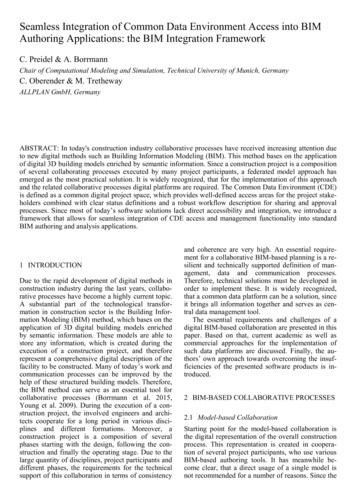



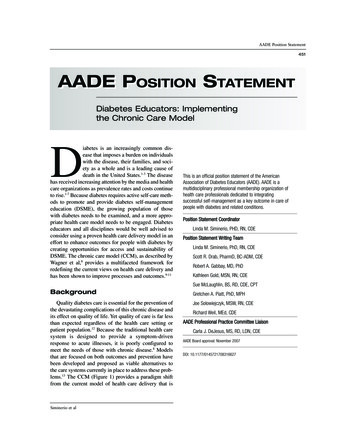
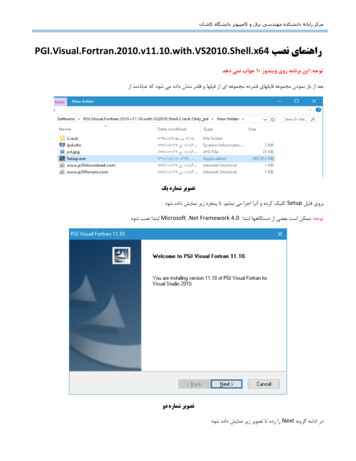

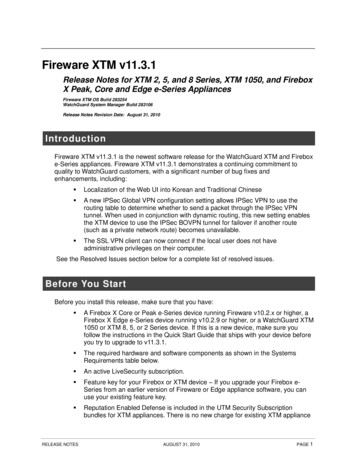
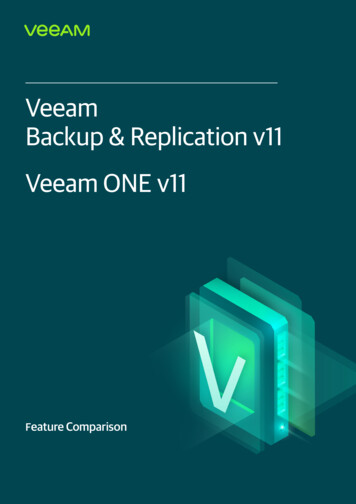
![[VERIFIED] Siemens Tia Portal V11 Crack 49 8](/img/66/olwder.jpg)
